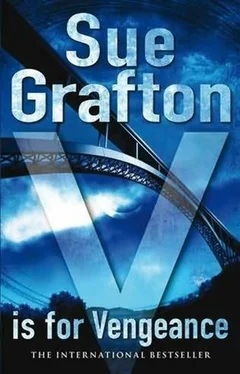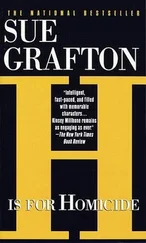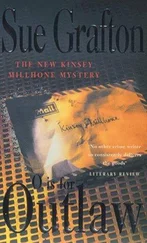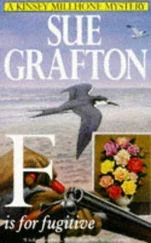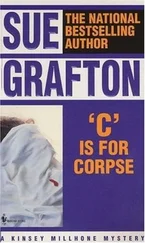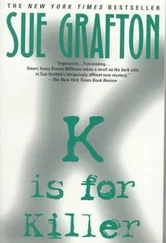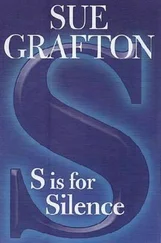Along the wide central plaza corridor there were boutique restaurants with outdoor tables, benches for weary shoppers, and kiosks selling sunglasses, junk jewelry, and women’s hairpieces. At the midpoint, a stage had been constructed where musicians played for summer tourists. I went up a wide set of red-tiled stairs to the second floor. To my right there was an auditorium available to local theater groups for stage productions. The mall business offices were located down a hall to the left.
Maria was waiting at the desk when I walked in.
“You’re a doll to do this,” I said.
“No problem. The police circulated the information to all the store managers and cc’d us so we’d know what was going on. Included with the bulletin was Audrey Vance’s mug shot.”
“Did you recognize her?”
“Not me, but I heard a salesgirl at Victoria’s Secret saw her the same day. Apparently, she’s a regular customer and nobody had any idea she was stealing from them. They’re doing an inventory check now to see how badly they were hit.”
“I thought these gangs originated in South America.”
“Those are the worst. They can sweep through and clear a tabletop in the blink of an eye. They blast into town and they’re gone again just that quick.”
“How does it work? They have to be highly organized, but I don’t understand how they operate.”
“You start with the worker bees, who go out and steal the merchandise. Sometimes they’re given a regular shopping list, products the fence knows he can sell. For instance, there’s a big traffic in Gillette razor blades, Tylenol, Excedrin, pregnancy tests, diabetic test strips. I’ve heard Oil of Olay products are a hot ticket as well. The list goes on and on and changes all the time.”
“You mentioned Victoria’s Secret.”
“Sure. Think how many bras you can fit in a shopping bag. Same with panty hose. It’s much tougher to steal bulky items like men’s cologne sets or VCRs. You can’t jam a TV down the front of your pants.”
“But where does the fence lay off the goods?”
“Swap meets are a good bet, thrift stores-places like that. A lot is shipped out of the country.”
“Are these rings run by the mob?”
“Not in the old-fashioned sense of the word. If the business was mob-run, you’d have a widespread network that might be vulnerable to infiltration. These crews are connected loosely, if they’re connected at all, which makes apprehension and prosecution a pain in the butt. In each city, the setup is different, depending on how many people have been brought in and what kind of fencing operation is up and running in any given area.”
“I remember the good old days when I was a rookie, shoplifters were amateurs.”
“Not anymore. We still have the dabblers and wannabes, teenagers sneaking record albums into their backpacks, thinking they can get away with it. Kids are the least of our worries. Though if you ask me, we ought to go after them and nail them.” She waved a hand, impatient with the subject. “Don’t get me started. Come on back and let’s take a look at what we’ve got.”
“You still like the new job?”
“I love it,” she said over her shoulder.
I followed her down a short hall to an office outfitted with closed-circuit television cameras massed together in an alcove. There were ten monitors mounted in proximity, all working independently. A young man in civilian clothes sat in a swivel chair, remote control in hand, following the live images as they flipped from view to view. The two of us stood and watched.
Depending on the angle, I could just about guess where each camera was mounted, though, in truth, I’d never noticed them before. Both entrances and both exits of the parking garage were covered. There were an additional six cameras anchored at the second-floor level, each one focused on a different line of sight. I followed one shopper from the time she entered the mall off State Street until she turned left into the main avenue and disappeared from sight. Another camera picked her up as she proceeded down the wide walk toward Macy’s and went into the store. None of the pedestrians seemed to have any idea they were being watched.
“These work off coaxial cables,” Maria said. “All of the cameras operate at the same time. By swapping out cassettes, we can capture images twenty-four hours a day over the course of a month. Unless we have reason to keep a cassette, we tape over what we’ve done. Eventually the tapes get worn or the CCTV heads get dirty, and the images end up fuzzy and not much use. After I talked to you, I pulled the cassette from last Friday.”
She turned to her desk and picked up four cassettes. “There’s a VCR next door.”
We went into the next office, which was plainly furnished and looked like it was called into service on occasions when a mall executive was in town and needed temporary space. She pulled up a straight chair for me while she took the swivel chair behind the desk and rolled it closer to the set. The VCR was wired to a small black-and-white television that looked like something right out of the 1960s, the screen small and the housing enormous. She checked the date on the first cassette and slid it into the machine. “You said between five thirty and six fifteen?”
“Roughly. It was five twenty-six when I looked at my watch. That’s when I first saw Audrey slide the pj’s into her bag. She was the older of the two women working the lingerie department. By the time the loss-prevention officer was called and the whole scene played out, I’d say it was closer to five forty-five,” I said. “I could be off. Time gets distorted when you’re caught up in these things. At the time, everything went by in a blur and that’s why I missed the plate number. I was so astonished at what happened I didn’t register much else.”
“I know the feeling. On the one hand you’re hyperaware and at the same time you blank out the details.”
“Amen. I couldn’t for the life of me go back and reconstruct the incident.”
“Don’t I know,” she said. “A foot chase you swear took fifteen minutes turns out to be half that. Sometimes it works the other way.”
With a remote, she fast-forwarded. Date and time stamps sailed along in the upper right-hand corner. It was like watching an old-time movie, people walking herky jerky, cars zooming by so quickly they seemed to leave a trail of afterimages. I was amazed at how much the eye could pick up from that fleeting series of pictures. When she reached April 22, she slowed the stream of images to a more stately pace.
I pointed and said, “There.”
Maria hit the pause button and rewound the tape.
The black Mercedes sedan, which was halfway up the ramp, reversed itself and disappeared from sight. She advanced the film by degrees. The car reappeared and I saw the younger woman hand a ticket to the parking attendant, who ran it into her machine. The attendant verified the time stamp, put the ticket to one side, and waved her on. The younger woman looked left and smiled, smug and self-satisfied. That much I remembered. As the sedan continued up the ramp, Maria paused the tape again, freezing the shot of the rear bumper. The license frame was in view but the plate had been removed.
“Now you know why you missed it,” she said.
“What shitty luck. I thought if I picked up the plate number, someone at the PD might run it for me.”
Maria said, “Let’s look at it again.”
She caught the Mercedes on its way up the ramp. It came to a halt with a flick of her remote and disappeared from sight, reversing down the ramp. We watched it as though it were the slow-motion photo finish of a horse race. “Check the license plate frame,” she said. “Top says, ‘Keep honking…’ Bottom says, ‘I’m reloading.’”
Читать дальше
